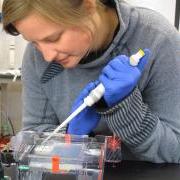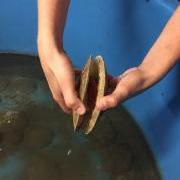Scallop survey in a tube: Skylar Bayer is developing a molecular technique to detect scallop spawning events in the field
NOTE: This blog was written by Skylar Bayer, a graduate student at the University of Maine, working on a Sea Grant-funded project with Dr. Rick Wahle of University of Maine, and Dr. Pete Countway of Bigelow Laboratory for Ocean Sciences.
The main objective of our project is to develop a qPCR survey technique as a quick and reliable way to detect giant sea scallop (Placopecten magellanicus) gametes (eggs and sperm) in nature. Working on this project has been a fantastic opportunity to tackle the question of reproduction of invertebrates in the field with molecular tools. After years of quantifying spawning events by deploying, retrieving and counting thousands of fertilized eggs, a method like this could save a lot of time and capture spawning events that researchers can’t be present for.

For our project, the steps involved in developing this method are: (1) selecting a region of the scallop genome, (2) developing a probe and primer set to detect this region, and (3) testing if it works across a dilution series of scallop sperm and eggs to quantify the relationship between number of cells and probe florescence.
Quantitative real-time PCR basically allows you to select a genetic sequence you are targeting, bind a fluorescent compound to it, and essentially measure that flourence to quantify how much of that genetic sequence exists in your sample. You can relate this back to how many or the quantity of cells of the target are present in your sample. If you are sampling water, this is a great way to measure how many of a single-celled organism or say gametes (sperm and egg) are in the water.
The area we targeted to develop a probe for is the transcribed spacer (ITS) region. This region is the non-coding DNA located between the small-subunit ribosomal RNA (rRNA) and large-subunit rRNA genes in the DNA of an organism. All organisms have genes for creating ribosomal RNA because ribosomes are responsible for translating DNA codes into proteins – in short, this is safe region to target because all animals have them and they’re very species specific.

So far, we have learned that the probe and primer set we’ve developed have worked on our samples run through qPCR already. Which is fantastic! We’re also seeing differences between very dilute and concentrated sperm samples in our qPCR which suggests that this method could not only detect gametes in the field, but be able to quantify their abundance.
Ultimately, we hope this method can be used to gain a more realistic estimate of scallop reproduction in nature to improve stock assessment models.
